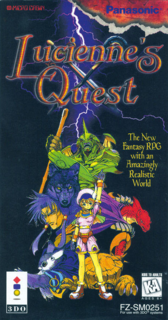Lucienne’s Quest, also known as Sword & Sorcery on the Saturn in Japan, is the only traditional turn-based RPG for the 3DO. The story is simple: A master mage, who lives and teaches magic to a group of youngsters in a tower, leaves to go on a journey, leaving his young apprentice, Lucienne, in charge. Soon, a man named Ago, cursed as a werewolf, asks for help to cure his lycanthropy. This small quest quickly turns into a larger quest to prevent an evil sorcerer, Death Shadow, from ruling the planet. There is a persistent lack of seriousness in the storytelling department. Its heroine is primarily portrayed as aloof, docile, absentminded, yet determined. The dialog is cut-and-dry for an old-school, '90s JRPG, but it is often entertaining. Many minor loose ends in the plot are not resolved, such as a cure for Ago or the details of the master mage’s journey.
The plot moves along rather quickly using a simple formula. Lucienne helps a neighboring town by defeating an oppressor (usually a minion of Death Shadow), and in return she is granted information about how to resolve the next minor conflict or how to confronting Death Shadow. The player explores towns and dungeons, where battles and interaction with NPCs and the environment take place, as well as the world map, which features a day/night system and a mostly linear layout.
The visuals will draw attention immediately. Lucienne's Quest is portrayed using 2D sprites in a fully 3D world. They are simply horrendous by modern standards but feature beautiful, bright colors; varied, distinct environments; vertical scaling; and transparency. Although not game breaking, Lucienne's Quest runs relatively slowly on the 3DO hardware, with noticeable load times between areas and entering and exiting battles. Overall, the visuals are among the most charming aspects of the game, especially as it is an early approach to 3D rendering.
The player controls Lucienne as well as four other players, who have special abilities to aid in battle. The battle system is this game's bright spot. Random encounters occur only on the world map, but in dungeons, battles are initiated when reaching wide or long sections. When approached, these sections are then zoomed in and isolated, forming an isometric battleground not too different from Super Mario RPG, where your characters are on one end and the enemies on the other. The battleground is grid based, and characters and enemies can move in two rows, front and back. No characters can move to the middle of the battleground, for example. Equipped with items, accessories, HP, and MP, each character attacks with a physical attack or a magic attack from either end of the battleground.
Battlegrounds feature destroyable objects, such as trees, pillars, or boxes, as well as environmental effects, like lava or poison, which can slowly decrease HP. These features demand an element of strategy from the player, as characters and enemies will shift around either by hiding behind or destroying objects to attack an enemy. One character who joins Lucienne in her quest, Kaneyung, has the ability to jump over certain objects and thus directly strike the enemy. Another character, Be-o-Melda, can toss objects at enemies. Ago can experience a dramatic increase in offensive and defensive abilities if battles take place at night or in shadow. Another party member, Miminaga, can "play dead" when his HP is low, tricking enemies into not attacking him. In addition, each of these characters features at least one special magic attack. The formation of each character on the battlefield is customizable (i.e., the player can determine who is in front, who is in back, and in what order). Lucienne "learns" magical abilities by talking to certain NPCs in towns. The game encourages not only "breaking" every object in towns and dungeons to find items but also speaking to other characters.
The biggest, most glaring issue with Lucienne's Quest is the lack of variety. The music, most of which is pleasant, unique, and suitable, is extremely repetitive, and the bosses, save for Death Shadow, do not get their own music track. Although the music is mostly good overall, it can grow tiresome due to the short length of each track. Clocking in at around 15 hours to complete, there are no sidequests, save for searching for every treasure chest in each dungeon and talking to every NPC to learn a magic ability. This means the player will be crunching the same formula (town-map-dungeon) the duration of the game.
In short, play Lucienne's Quest for the exciting battle system, unique visuals, and good music. It is a repetitive, mostly uninspired experience with a few tricks up its sleeves.

